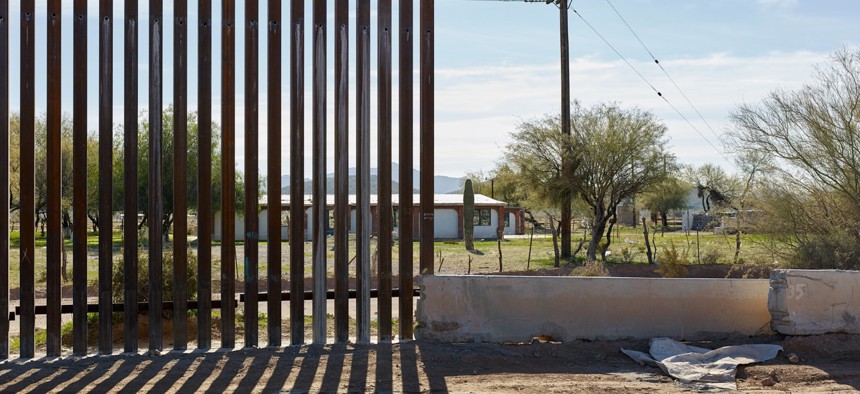
MARK POWER / MAGNUM
The Border Mess That Trump Left Behind
Reversing the previous administration’s cruelties isn’t the same as an unconditional welcome.
As President Joe Biden tries to undo the damage that his predecessor did to America’s immigration system, three problems are getting in the way: The nation’s existing laws are outmoded and overly restrictive, the United States hasn’t devoted the resources necessary to review individual cases, and the Biden administration has little control over when migrants will arrive at the border and seek entry.
Soon after taking office, Biden moved to dismantle Donald Trump’s nastiest immigration and border-enforcement policies. Biden has lifted Trump’s ban on travelers from certain Muslim countries; halted construction of a wasteful border wall; promised to protect enrollees in the Deferred Action for Childhood Arrivals program, whom Trump was ready to deport; and launched a task force to reunite migrant families separated at the border. Yesterday, he proposed reform legislation that, if enacted, would give undocumented immigrants now in the U.S. a route to becoming citizens.
In the meantime, the U.S. border is coming under stress. Biden’s more humane policies have led to rumors that the U.S.-Mexico border is now essentially open, both for asylum seekers who show up at ports of entry and for others who cross unlawfully. Smugglers are eager to spread that idea. For the moment, the United States’ humanitarian interest lies not just in showing kindness to those who reach the border, but also in stemming the flow of people who undertake the journey in the first place.
The Trump administration defined itself with its efforts to shut down immigration, and Biden largely defined his presidential candidacy as a repudiation of Trump. But, ironically, the new administration finds itself imploring potential migrants not to head north. “Now is not the time to come,” White House Press Secretary Jen Psaki said last week. “The vast majority of people will be turned away.”
Customs and Border Protection reported nearly 78,000 “encounters” in January at the southwest border—that is, 78,000 apprehensions or deportations of would-be immigrants. That’s nearly double the figure for the same month last year and the highest for January in a decade. If the current pattern holds, the U.S. is on track for more than 1 million encounters in 2021. “I see a Category 5 hurricane in the Gulf, and we just now have the tropical storm force winds on the coast,” an immigration-shelter worker recently warned CBS News.
As matters stand, the U.S. government doesn’t have enough immigration judges and attorneys to evaluate asylum claims, and existing Border Patrol stations and other facilities are inadequate for processing applicants during a pandemic. People who are fleeing persecution and violence deserve refuge, but not every border crosser qualifies for asylum. Determining who is eligible takes effort and resources. “The central challenge is that building capacity to efficiently and fairly process asylum claims necessarily will take time,” Alan Bersin, the former head of Customs and Border Protection under President Barack Obama, told me. “Reforming systems while they are processing large and increasing numbers of new arrivals can result in a crushing and self-defeating burden.”
In the meantime, even as conservative lawmakers and Fox News commentators stir up fears of would-be immigrants, many in the Democratic Party are deeply uncomfortable with the standard tactics of border enforcement. Immigration-rights activists dismayed by Obama’s enforcement efforts criticized him as the “deporter in chief.” The cruelties of the Trump era pushed the party’s rhetoric farther to the left. Many Democratic candidates during the 2020 presidential-primary season supported decriminalization of unlawful border crossings, and activists and officials on the party’s progressive flank support the outright abolition of Immigration and Customs Enforcement. Both positions, however, are unpopular among an American public that generally supports immigration.
Perhaps not coincidentally, the candidate who won the Democratic nomination and the presidency took more moderate stances. Now Biden has the tricky problem of squaring his own sense of empathy and the expectations of his party’s base with the duty to protect America’s borders under existing laws.
Under Trump, the federal government failed to build up its own capacity to manage migration surges and arbitrate individual cases. The Trump team tried simply to keep migrants out. When the coronavirus pandemic arrived, Trump invoked the CDC’s authority to expel any border crossers. Although Trump failed to get Mexico to pay for his wall, he managed to bully that country in 2019 into taking on responsibility—via the so-called Remain in Mexico program—for holding asylum seekers who sought to enter the U.S.
But Mexico’s patience is waning, and the dangerously cold weather conditions befalling people housed in tents just south of the border this week are one more reminder of Washington’s failure to manage basic logistics—even before the arrival of a new surge of migrants. Only now is the U.S. beginning to accept asylum seekers previously enrolled in Trump’s Remain in Mexico program. That program has 25,000 active cases, which will be handled at a rate of only 300 a day.
The Biden administration needs to buy time, communicating to potential new migrants that the border is still controlled and keeping the CDC order in place for now. Mexico’s president, Andrés Manuel López Obrador, is also warning against false rumors that “the doors are open” in the United States. At the same time, the U.S. has to make better preparations for how to handle those who do arrive at the border. Rumors—and the hopes of people seeking a better life—are hard to quell. But Biden will have more maneuvering room, both operationally and politically, if he succeeds in signaling to migrants that they should not travel to the border immediately—and that an easing of Trump’s policies is not the same as an unconditional welcome.
Juliette Kayyem is a former Department of Homeland Security official and author of "Security Mom."
NEXT STORY: The Day Private Willie Mays Threw Out My Dad



